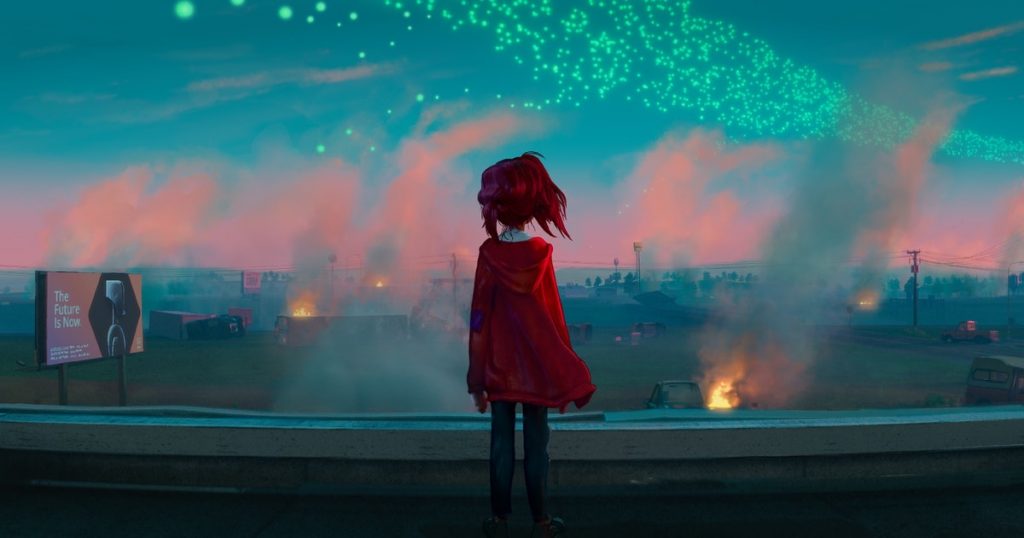
taken from: https://www.tunefind.com/movie/connected-2020
Sony Pictures’ The Mitchells vs. The Machines is a fantastic movie featuring a unique, visually stunning art style, genuinely funny moments, and a captivating storyline. However, what the movie does best – and why I think it’s worth discussing in this course – is its usage of modern themes and concepts that possess an incredible degree of relatability and relevance in our digital age.
The movie follows the story of a dysfunctional family (the eponymous Mitchells) who are the only remaining free humans on Earth after a robot uprising imprisons everyone else. Thematically, the inescapable nature of social media/the internet is central to the plot. The entire concept of the film would not be successful if social media was not as pervasive as it is. The movie overtly represents the effect that social media has on how we view ourselves and the world. As an example: portrayed as the perfect family unit both on social media and online, the Posey family’s cohesiveness acts as a foil to the Mitchells’ chaotic dynamic. Linda, the mother of the Mitchells, is noticeably insecure of her own family as a result of seeing their perfection on the movie’s version of Instagram. More overtly, they are literally called the Posey family, so there’s that.
This can be seen as a representation of Goffman’s front stage/backstage concept, as Linda struggles with reconciling the reality of her own family dynamic with the ideals of family represented online. Interestingly, the Poseys are actually just like that – they seemingly are as perfect in person as they portray themselves on social media. However, without spoiling too much, the movie confronts the norm of presenting a flawless front stage persona. Instead, it promotes the idea that imperfection is human, and that it is normal to be abnormal. As the target demographic for this film seems to be children or teens, the relaying of this message comes at an increasingly relevant time. It allows for young minds to reconsider the normative ideals that have been reinforced through growing up in the age of social media in an accessible, relatable way, and I think that’s pretty cool. Of course, this type of messaging in children’s movies is nothing new, as the general moral of ✨ be yourself ✨ has existed for a while now. What The Mitchells vs. The Machines does differently is that it repackages these messages in a way that thoughtfully considers the modern pressures we all face.
The movie also tackles the disconnect between older generations who grew up in an era without the internet and younger generations who seemingly cannot live without it. Naturally, these perspectives come with conflict as neither one can understand the other. By the end of the film, it presents both as valid without detracting from the other, and allows for a more holistic view of the internet for both generations. You can see how this type of messaging is valuable in an era where divisiveness is seemingly encouraged – especially for younger viewers who might lack the ability to empathize with the perspectives of their out-of-touch parents, or for parents who can fail to understand the impact of growing up in a world dominated by the internet.
Finally, we can loosely tie this film to Burgess & Green’s YouTube: Online Video and Participatory Culture. Throughout the movie, we can see the development of the relationship between Katie (the Mitchells’ creative teenage daughter who wishes to escape her family by attending a university for film) and her father, Rick. Katie makes quirky videos and uploads them onto YouTube, an interest which she has had since she was a child. Despite her attempts to connect with her father through these videos, Rick fails to understand the importance of these videos and repeatedly rejects Katie’s attempts at bonding. He does not support Katie’s dreams of becoming a filmmaker and sees it as a waste of time. As a result, a wedge is driven between the two and serves as one of the main conflicts throughout the movie. Rick’s perspective of Katie’s videos perhaps reflects the initial media perspectives of YouTube as a chaotic, amateurish platform as described in Burgess & Green’s text (2018, 28). He worries about Katie’s potential to succeed before she even has a chance to try, and discourages her from pursuing her passion. In this way, the film juxtaposes Rick’s perspective with Katie’s belief in her ability to create content that people will watch, and by ultimately recognizing the value or success of digital media, it confirms Burgess & Green’s view of YouTube as a culturally cultivated force that can lead to success. It accepts the notion that social media can lead to wonderful things whilst also acknowledging the fears surrounding it, which is a refreshingly balanced take. It’s a great movie and it’s on Netflix, so please watch it if this sounds at all interesting to you!
(NB: The movie also features a good representation of an LGBT character, so if that matters to you, you might enjoy it even more!)
References:
https://www.tunefind.com/movie/connected-2020 (image)
Bullingham, Liam, and Ana C. Vasconcelos. ‘“The Presentation of Self in the Online World”: Goffman and the Study of Online Identities’. Journal of Information Science 39, no. 1 (1 February 2013): 101–12. (briefly referenced)
Burgess, Jean, and Joshua Green. Youtube : Online Video and Participatory Culture. Second edition., 2018.


Recent Comments